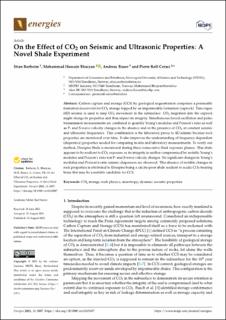| dc.contributor.author | Rørheim, Stian | |
| dc.contributor.author | Bhuiyan, Mohammad Hossain | |
| dc.contributor.author | Bauer, Andreas | |
| dc.contributor.author | Cerasi, Pierre | |
| dc.date.accessioned | 2022-03-01T11:21:25Z | |
| dc.date.available | 2022-03-01T11:21:25Z | |
| dc.date.created | 2021-08-27T07:59:52Z | |
| dc.date.issued | 2021 | |
| dc.identifier.citation | Energies. 2021, 14 (16), 1-20. | en_US |
| dc.identifier.issn | 1996-1073 | |
| dc.identifier.uri | https://hdl.handle.net/11250/2982050 | |
| dc.description.abstract | Carbon capture and storage (CCS) by geological sequestration comprises a permeable formation (reservoir) for CO2 storage topped by an impermeable formation (caprock). Time-lapse (4D) seismic is used to map CO2 movement in the subsurface: CO2 migration into the caprock might change its properties and thus impact its integrity. Simultaneous forced-oscillation and pulse-transmission measurements are combined to quantify Young’s modulus and Poisson’s ratio as well as P- and S-wave velocity changes in the absence and in the presence of CO2 at constant seismic and ultrasonic frequencies. This combination is the laboratory proxy to 4D seismic because rock properties are monitored over time. It also improves the understanding of frequency-dependent (dispersive) properties needed for comparing in-situ and laboratory measurements. To verify our method, Draupne Shale is monitored during three consecutive fluid exposure phases. This shale appears to be resilient to CO2 exposure as its integrity is neither compromised by notable Young’s modulus and Poisson’s ratio nor P- and S-wave velocity changes. No significant changes in Young’s modulus and Poisson’s ratio seismic dispersion are observed. This absence of notable changes in rock properties is attributed to Draupne being a calcite-poor shale resilient to acidic CO2-bearing brine that may be a suitable candidate for CCS. | en_US |
| dc.language.iso | eng | en_US |
| dc.publisher | MDPI | en_US |
| dc.rights | Navngivelse 4.0 Internasjonal | * |
| dc.rights.uri | http://creativecommons.org/licenses/by/4.0/deed.no | * |
| dc.title | On the Effect of CO2 on Seismic and Ultrasonic Properties: A Novel Shale Experiment | en_US |
| dc.type | Peer reviewed | en_US |
| dc.type | Journal article | en_US |
| dc.description.version | publishedVersion | en_US |
| dc.source.pagenumber | 1-20 | en_US |
| dc.source.volume | 14 | en_US |
| dc.source.journal | Energies | en_US |
| dc.source.issue | 16 | en_US |
| dc.identifier.doi | 10.3390/en14165007 | |
| dc.identifier.cristin | 1929114 | |
| dc.relation.project | Norges forskningsråd: 268445 | en_US |
| cristin.ispublished | true | |
| cristin.fulltext | original | |
| cristin.qualitycode | 1 | |

